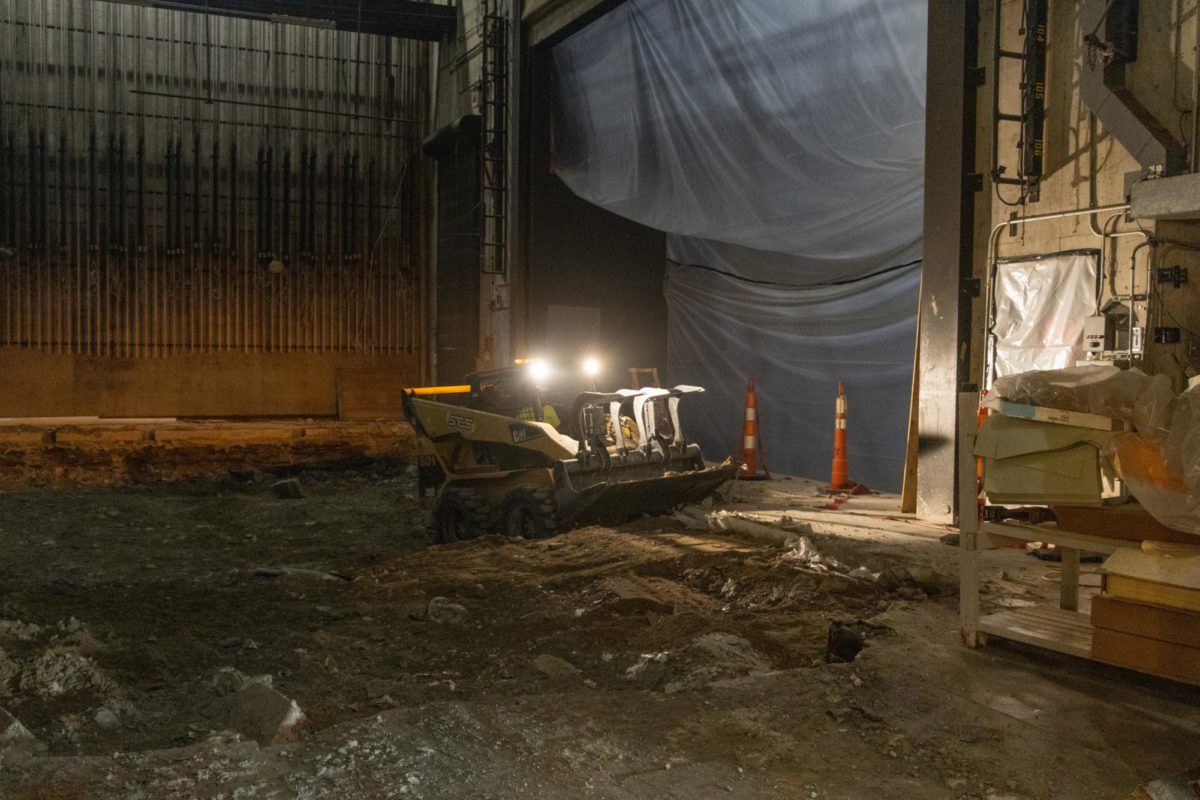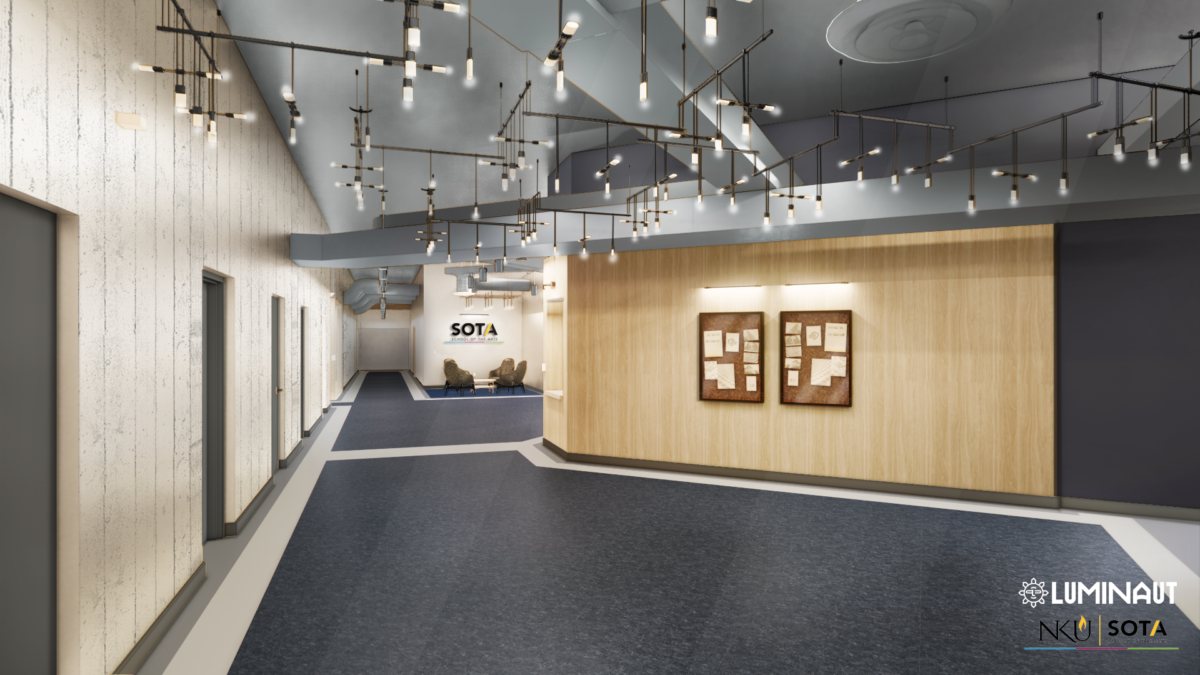The School of the Arts community was welcomed back to campus this fall to a restricted first floor and the occasionally perturbing ambiance of its demolition as a bulk of the Fine Arts Center’s first floor is being gutted and renovated. Factors prompting the project have been monitored for years, and with the funding in hand, the school is set to usher in a new era of modernized facilities next fall.
Still, the project has struck mixed emotions among students, faculty and staff as they grapple with the short-term implications.
What’s happening
Scattered around campus are subsurface expanses of shale. When water trickles through the ground, the shale absorbs it and gradually swells, applying upward pressure on the building’s floor and concrete walls. Overtime, parts of the Fine Art Center’s first floor have heaved and created uneven surfaces, according to Senior Director of Planning, Design and Construction Mary Paula Schuh.
While the abnormality isn’t an immediate structural threat, it could become one if left to fester: “When that ground floor slab moves up, it pushes that concrete wall up, which then puts pressure on the second floor slab, which causes it to crack, causes the beams to crack, which then becomes a structural concern,” said Schuh.
Shale deposits have been identified in numerous campus buildings over the years: Fine Arts Center, Business Academic Center, Steely Library, Nunn Hall, Natural Science Center and Landrum Academic Center, according to Schuh. They’ve been corrected in the class-wing of Landrum Academic Center and in Founders Hall, and it’s currently being addressed in both the Fine Arts Center and Nunn Hall, said Schuh.
The floor slab is being demolished, creating a hole about four-feet deep. A new floor slab will be constructed on top of support beams, forming a void between the building’s concrete footers and the new floor that will allow the shale to expand without stressing the floor, Schuh explained.
The renovated facility will feature updated iterations of the Patricia D. Corbett Theatre and The Henry Konstantinow Studio Theatre, American Disability Act-compliant dressing rooms, a new gender-neutral dressing room, a single-person restroom, as well as redone versions of the dance and acting studios, scene shop, prop shop and paint shop, according to the senior director.
Funds for the project are coming in part from the state of Kentucky as asset preservation funding, which the university is required to match a portion of. The current asset preservation fund is made up of $46,794,000 provided by the state and $7,020,000 by NKU—totaling $53,814,000. $13,240,000 of the asset preservation fund is apportioned to the project in the Fine Arts Center, including $11,513,504 from the state and $1,726,496 from the university, according to Schuh.
The project is expected to be finished in August 2024, in time for the next academic year. The demolition phase is expected to be complete around October, said Schuh.
All parts of the Fine Art Center’s mechanical and HVAC system—which is original to the building built in 1977—will be replaced eventually as well. An exact schedule for that project is unclear as some components are yet to be received or ordered, according to Schuh.
The college has tried to maintain business as usual. Some classes have shuffled to new classrooms to mitigate distractions. Many classes have stayed in the Fine Arts Center because of specialized equipment, like computer software, instruments and studios that can’t be supplanted elsewhere, said Matthew Albritton, director of SOTA.
Other classes that were intended to take place on the second floor of the Fine Arts Center have moved into Landrum Academic Center, Founders Hall, Health Innovation Center and Campus Rec, according to a Theater and Dance Program Canvas announcement obtained by The Northerner. Rehearsals for SOTA’s dance and theater productions are being held in Campbell Hall this year, a nonacademic building on the northern edge of campus.
Holding classes in the wake of the construction has engendered some obstacles to learning and teaching, mostly related to obstructive noise and vibration when jackhammers are being used. Several students have also reported fumes exuding from the first floor, with some raising concerns about the safety of being indoors during the work.
Carbon dioxide detectors are installed on all vehicles involved in the project to ensure healthy air quality in the building, said Liz Birkenhauer, associate director of Planning, Design and Construction. Fans with carbon neutral filters are also set up to cleanse the air throughout the work area, she said.
Sound echoing throughout the building stems from two main processes: jackhammering to raze the floor’s foundation and loud bangs as a bulldozer deposits large portions of debris into a dumpster. While the frequency of jackhammering is expected to tail off as sections that can’t be uprooted with other equipment are removed, quieter demolition and construction methods will persist throughout the year, said Albritton.
How students and faculty are faring
Students and faculty are acclimating to the episodic ruckus, but some instances have proven to be roiling.
Max Mason, a third-year musical theatre major, said one of her acting classes was moved into Landrum Academic Hall during the first week of the semester to avoid the noise. The space, although workable, was tight and left some students sitting on tables and limited the available space to reenact class content. Mason’s professor, Nicole Perrone, decided to move the class back to its original location on the second floor of the Fine Arts Center.
“She was like, ‘no matter what, we’re going back to our original room today,’ which we did. And it was great, because the Landrum room was so small. It’s not meant for theater,” said Mason.
Some music classes have been moved to other buildings too. Logan Leverett, a fourth-year music major focusing on performance jazz, said one of his music theory classes was moved into Landrum Academic Hall. Normally, music theory would be taught in a classroom with a piano so the professor can readily provide auditory references to the class’ discussion, but there is no piano in the alternative room, said Leverett.
Leverett plays in the Commercial Music Ensemble and the Jazz Ensemble, which meet in Greaves Concert Hall and the band room on the first floor, which is adjacent to the construction but unaffected. So far, the ensemble has been able to overshadow any noise emitted by the construction during their rehearsals, said Leverett.
Third-year vocal performance major Meg Booker utilizes the second floor private-practice rooms, which she said are easily affected by the jackerhammering’s noise and rumbling: “It can be really distracting. When you’re trying to practice or when you’re trying to hear yourself sometimes it can just get too much,” she said.
Some classes that stayed in the Fine Arts Center have been plainly disrupted by the construction noise.
Visual communication design professor Julie Mader-Meersman said she moved one of her classes outdoors during week one to escape the rattle of jackhammering, only to realize that the crash of debris being dumped was still present.
Albritton said his first class of the semester was riddled with the thunderous pound of jackhammers. He made a point to remind students that the inconvenience is a sign of support: “It’s going to be a little bit inconvenient, a little bit invasive. Certainly with the sound, but it’s support. We are getting this thing fixed,” he said.
Screen printing courses, which have a specialized room and equipment on the first floor, are being taught in Fine Arts Center 309 this year. Part of the screen printing room is being remodeled, according to printmaking and screen printing professor Randel Plowman. When finished, the room will feature a new storage space, an office and a darkroom, he said.
Plowman believes the changes represent an upgrade, but he’s had to be flexible with his instructional space in a state of flux. Only one printing press was able to be moved upstairs to where he is teaching this year; the remaining printing presses are draped in plastic tarps and coated with dust from the construction.
He’s having his students focus more intensively on digital printmaking with a Risograph—a machine that digitally mimics the manual process of screen printing—which students pursuing the screen printing microcredential would learn anyways. Demand for the single printing press currently in use hasn’t become an issue yet, said Plowman, but projects later in the semester may cause use of the equipment to be more contested.
Despite the obvious ameliorations poised to come, students The Northerner spoke with were confused and vexed about the construction not beginning until July 17, which has been communicated by flyers posted around the building.
“There’s a sign up there that says they did not start construction until July 17, which was halfway through the summer. Why could they not have started construction May 6 when we got out of school,” questioned Booker.
A proposal for bids was opened up by the university on May 16, said Schuh. The two months leading up to the project breaking ground was spent finalizing an agreement with the contractor and having them organize a team and get the necessary materials and equipment, said Birkenhauer.
Now a few weeks into the semester, students and faculty are gradually adjusting to the presence of construction and its reverberations. However, some students in the Theatre and Dance Program are worried that the construction will take longer than anticipated and delay their return to the facilities.
“I don’t think my education is being impacted at all. I still think I’m learning the same thing, so I’m just in a different environment, which can be hard, but I’m very appreciative of it. I’m just a little worried that I won’t get to go back my senior year,” said junior acting major Kiley Ernst.



